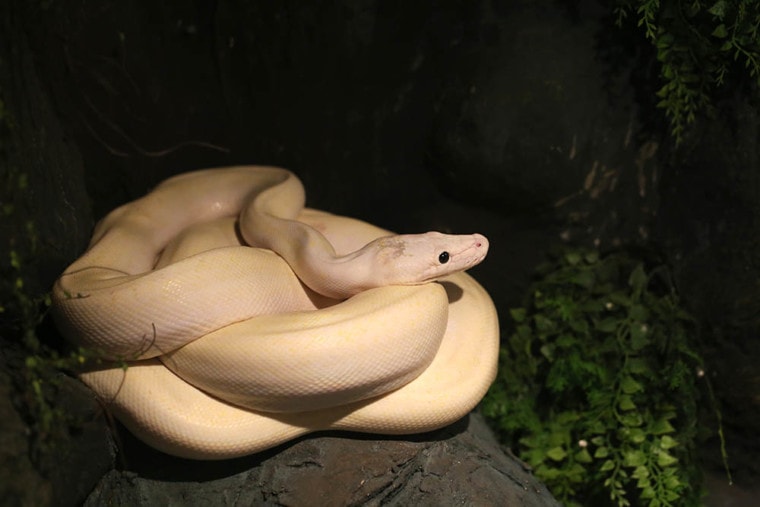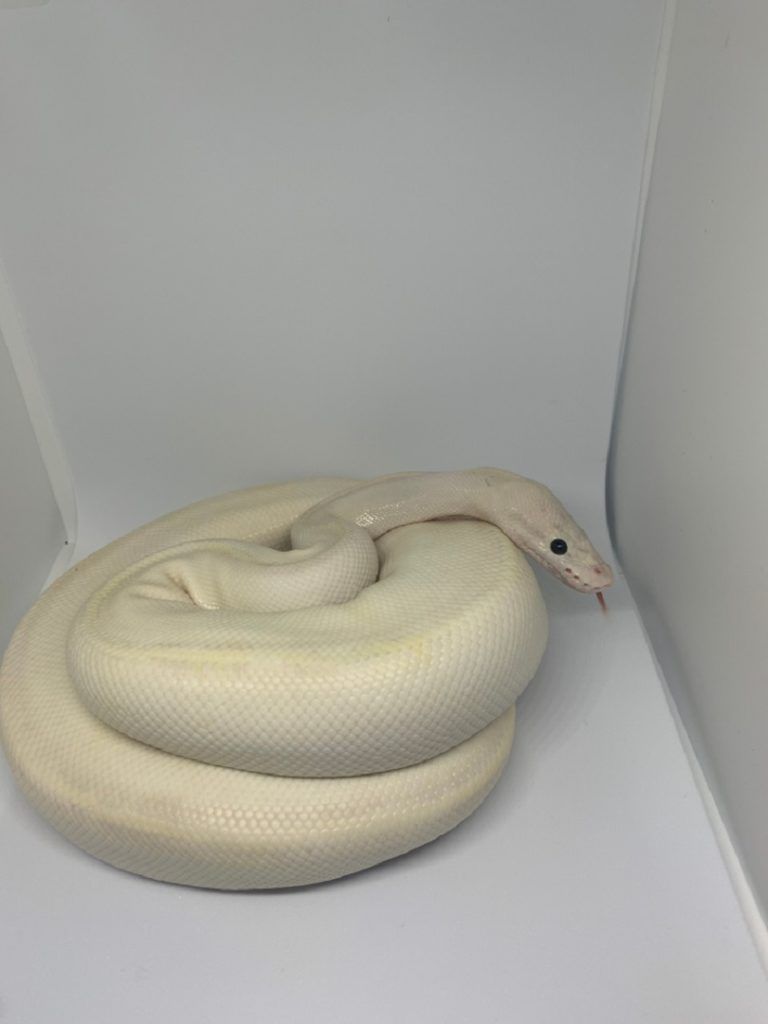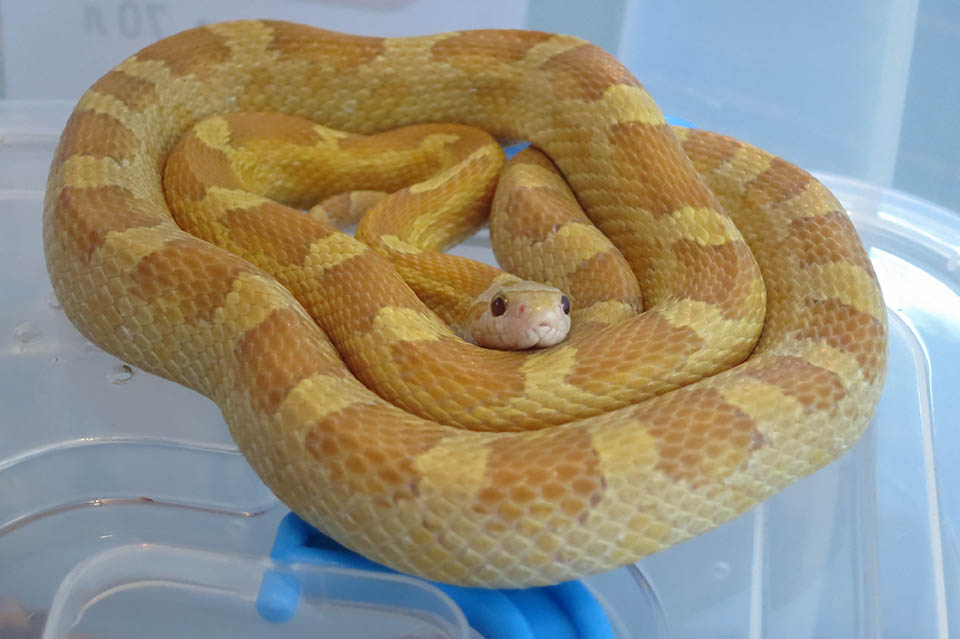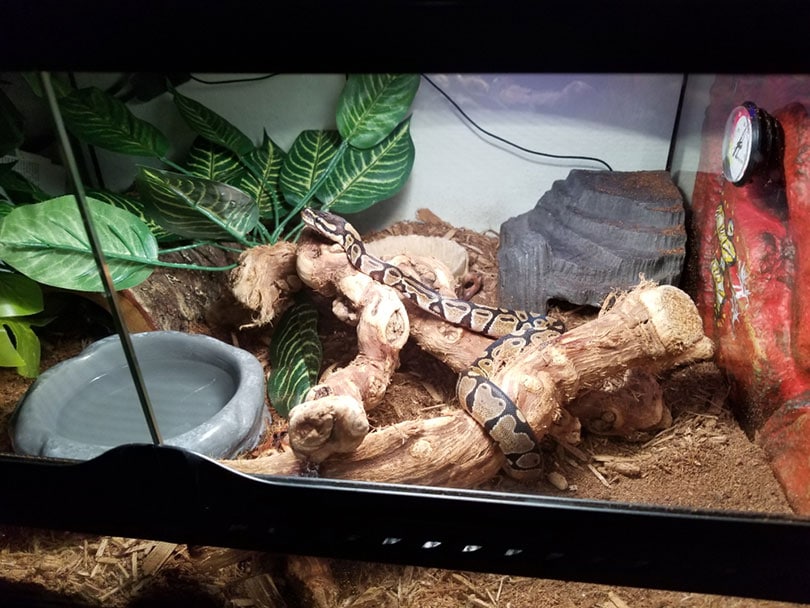
Ball pythons are definitely one of the most popular choices for snake lovers—and for good reasons. They are beautiful, low maintenance, and they come in just about any morph appearance you can dream up.
Ivory ball pythons have an extraordinary appearance, touting pearl, peach, and beige hues. This morph is rare and stunning, so if you’re lucky enough to stumble across one, read on to learn what you can expect about overall care.
Quick Facts about Ivory Ball Python Morph
| Species Name: | Python regius |
| Common Name: | Ivory Ball Python |
| Care Level: | Easy |
| Lifespan: | 30 years |
| Adult Size: | 5 feet |
| Diet: | Carnivorous |
| Minimum Tank Size: | 40 gallons |
| Temperature: | 75-92 degrees Fahrenheit |
| Humidity: | 50%-60% |
Do Ivory Ball Pythons Make Good Pets?
If you love the uniform colors forms, you might be totally smitten by the ivory ball python—these beauties win categories for appearance and superb temperament.
Because of their peaceful nature, they make ideal first-time snakes for children 6 and older. They require specific care, but the work is minimal, which means kids can pick up the concept quickly under supervision.
As a breeder, you might think that having a snake this color could create some eye-catching offspring, and you’re right! An ivory ball python can produce a stunning selection of potential morphs that are in high demand.
Overall, we think that the ivory ball python is an outstanding reptile for most living situations—and they would work very well as breeders, too. What’s not to love?

Appearance
Ivory ball pythons have a uniform color and are missing the classic banding patterns traditional ball pythons possess. Breeders produce the ivory color by breeding two yellow ball pythons. There is a 25% chance in every double yellow belly combo that you will get an ivory.
When you look closely at the ivory, you can see the light, soft hues of yellow—and this coloration is more subtle in some ivories over others. Mostly, ivories are off-white, with a noticeable yellow-to-peach line trailing the spine.
Ivories can make some very interesting-looking morphs when they breed with other snakes. Many breeders use them to mask or dilute an intense color—making a paler version of the non-ivory parent.
How to Take Care of Ivory Ball Python
It’s best to know as much as you can about the correct environmental setup for your ivory ball python. These slithering beauties need a particular setup to get all of the appropriate lightings and heat their bodies require.
Habitat, Tank Conditions & Setup
Tank
Even though your ivory will be small when you bring them home, eventually, an adult will need a 40-gallon tank to be happy. Ball pythons aren’t particularly active snakes, so they don’t need as much room as some reptiles.
These snakes appreciate limbs to climb as well as hides to curl up inside. Make sure to litter the cage with lots of fun things to do.
Lighting
Ball pythons require lighting that mimics natural daytime/nighttime cycles. Since snakes must have a light source for heat, some owners use UVB bulbs to give the snake a boost of vitamin D.
During night hours, you can turn off any lighting source. However, always make sure to have another heat source available to them, such as a heating pad, to avoid chilling.

Heating (Temperature & Humidity)
The temperature will fluctuate in the cage so your ivory can regulate its body temperature. On the cool side, temperatures should stay between 75 and 85 degrees F. In the backing area, the cage should get up to 92 degrees F.
You can offer both a heating lamp and a heating pad. It’s best to use the light during daylight hours and the heating pad during the night.
There is some controversy in the reptile world about precisely what suitable heat sources are for ball pythons, so consult your exotic vet to get the best advice.
Humidity is crucial for your ivory to shed correctly and avoid respiratory illness. For your ivory ball python, your hydrometer should read between 50% and 60%. You can mist the cage daily for optimal moisture.
Substrate
Since humidity is so important, you want to have a substrate that retains moisture quite well. But you also want to choose a substrate that doesn’t mold or collect bacteria.
Some of the best substrates you can buy for your ivory ball python include:
Tank Recommendations
| Tank Type: | 40-gallon aquarium |
| Lighting: | Low UVB light |
| Heating: | Heating pad/ basking lamp |
| Best Substrate: | Aspen, coconut bark, reptile bark |
Feeding Your Ivory Ball Python
Ivory ball pythons are predatory creatures that snack on small rodents—and sometimes insects, in the juvenile stage. These reptiles are slow growers, not reaching full size until 3 years of age—so their diet changes slowly.
Eating frequency will transform, requiring different portions along the way. Juvenile ivories should eat one fuzzy or pinky mouse twice per week. Adults can eat large mice or even rats, but you should slow feedings to every one to 2 weeks.
Diet Summary
| Fruits: | 0% of diet |
| Insects: | 0% of diet |
| Meat: | 100% of diet – small/medium-sized rodents |
| Supplements Required: | N/A |

Keeping Your Ivory Ball Python Healthy
Before you bring home your lovely ivory ball python, finding an exotic breeder is a must! Traditional veterinarians don’t have the special skills necessary to treat reptiles and other obscure pets.
Snakes are a little tricky when it comes to health. Many of them don’t show symptoms until the illness is very advanced, so keeping a close eye on behavior is important. You will want to recognize as many early cues as possible.
Common Health Issues
Here are some of the potential diseases or ailments your ivory may face:
Lifespan
If your ivory ball python is well-cared for and healthy, these snakes can live up to 30 years.
Many things that can shorten lifespan are easily avoidable, simple goofs. Consider every aspect of diet and environmental maintenance—these animals rely on you solely to survive.
While some issues are unavoidable, we can increase the livelihood of our pets by offering the most steadfast care we can.
Breeding
If you’re an experienced breeder and have some curiosities about the ivory, it’s perfectly understandable. These snakes are impeccable and capable of producing so many striking colors.
Ball pythons are relatively easy to breed if you already know a lot about what you’re doing. If you’re just starting, we encourage you to get all the information you can ahead of time, so you’re totally prepared for anything.
Female ball pythons need to be at least 2 years of age before breeding, but it’s best to wait until the 3-year mark. Each clutch produces between one and 11 eggs which hatch in 53 to 55 days.
Are Ivory Ball Pythons Friendly? Our Handling Advice
Ball pythons are incredibly friendly, no matter the morph. Ivory ball pythons won’t mind being handled often—but be mindful of space. If it seems like your snake is getting a little stressed, space out handling sessions.
It’s not typical that a ball python bites. They are generally calm but exploratory, wanting to check out all the things around them. So, when you do have them out—don’t let them out of your sight. They can get into the tiniest spaces—you’d be surprised.
Like any snake, don’t make any sudden movements, as your snake might perceive a threat. If they do, they could nip—and while harmless, no snake bite feels too good. So, just be respectful and calm while you hold your snake at all times.
Shedding & Brumation: What to Expect
When your snake is ready to shed, you will notice what looks like a light layer of dry skin forming on the scales. Usually, it’s first visible around the eyes. The entire process takes your snake about 1-2 weeks.
Technically, ball pythons do not brumate. However, they do get a little slower and might not eat as much during the winter months.
It’s best not to handle your snake if they are shedding or being lethargic.

How Much Do Ivory Ball Pythons Cost?
Ivory ball pythons cost a modest average of $200-$500.
Costs vary based on a few factors like breeder rates, quality, and age of the snake. Juvenile snakes cost less than adults, for example, as adults are much more valuable assets to enthusiasts and breeders.
Care Guide Summary

Final Thoughts
Does the beautiful ivory ball python sound like the next snake you want to add to your already stellar collection? If so, you might want to start browsing options near you. Since this morph is so specific, it may take some time to sift one out.
These beauties make lovely first pets, attractive breeders, and exciting family additions—so you can’t go wrong. Just ensure your snake is healthy before bringing it home.
Featured Image Credit: Sittisak Ua unnahakit, Shutterstock










